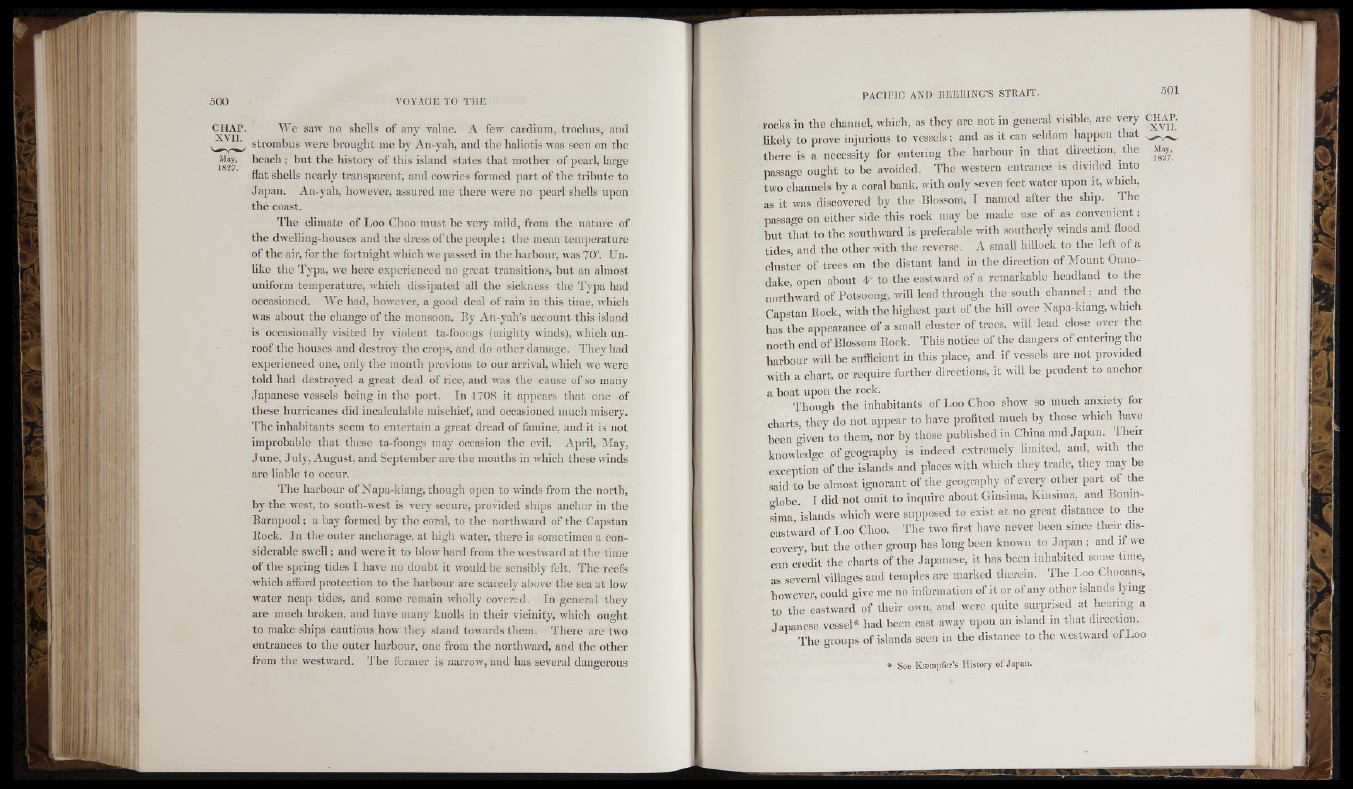
f!
: !MI
li jl
:5i
Í: ■ ii/iIr'
i : li
We saw no shells of any value. A few cardium, trochus, and
strombiis were brought me by An-yah, and the haliotis was seen on the
beach ; but the history of this island states that mother of pearl, large
flat shells nearly transparent, and cowries formed part of the tribute to
Japan. An-yah, however, assured me there were no pearl shells upon
the coast.
The climate of Loo Choo must be very mild, from the nature of
the dwelling-houses and the dress of the people ; the mean temperature
of the air, for the fortnight which we passed in the harbour, was 70°. Unlike
the Typa, we here e.xperienced no great transitions, but an almost
uniform temperature, ivhich dissipated all the sickness the Typa had
occasioned. We had, however, a good deal of rain in this time, which
was about the change of the monsoon. By An-yah’s account this island
is occasionally visited by violent ta-foongs (mighty winds), which unroof
the houses and destroy the crops, and do other damage. They had
experienced one, only the month previous to our arrival, which we were
told had destroyed a great deal of rice, and was the cause of so many
Japanese vessels being in the port. In 1708 it appears that one of
these hurricanes did incalculable mischief, and occasioned much misery.
The inhabitants seem to entertain a great dread of famine, and it is not
improbable that these ta-foongs may occasion the evil. April, Jlay,
June, July, August, and September are tbe months in which these winds
are liable to occur.
The harbour of Napa-kiang, though open to winds from the north,
by the west, to south-west is very secure, provided ships anchor in the
Barnpool; a bay formed by the coral, to the northward of the Capstan
Rock. In the outer anchorage, at high water, there is sometimes a considerable
swell; and were it to blow hard from the westward at the time
of the spring tides I have no doubt it would be sensibly felt. The reefs
which afford protection to the harbour are scarcely above the sea at low
water neap tides, and some remain wholly covered. Li general they
are much liroken, and have many knolls in their vicinity, which ought
to make ships cautious how they stand towards them. There arc two
entrances to the outer harbour, one from the northward, and the other
from the westward. The former is narrow, and has several dangerous
rocks in the channel, which, as they are not in general visible, are very C H A P ,
X V I I .
likely to prove injurious to vessels; and as it can seldom happen that
there is a necessity for entering the harbour in that direction, the
May,
1827.
passage ought to be avoided. The western entrance is divided into
two channels by a coral bank, with only seven feet water upon it, winch,
as it was discovered by the Blossom, I named after the ship. The
passage on either side this rock may be made use of as convenient;
but that to the southward is preferable with southerly winds and flood
tides, and the other with the reverse, A small hillock to the left of a
cluster of trees on the distant land in the direction of Mount Onnodake,
open about 4° to the eastward of a remarkable headland to the
n o r t h w a r d o f Potsoong, will lead through the south channel; and die
Capstan Rock, with the highest part of the hill over Xapa-kiang, which
has the appearance of a small cluster of trees, will lead close over the
north end of Blossom Rock. This notice of the dangers of entering the
harbour will be sufficient in this place, and if vessels are not provided
with a chart, or require further directions, it will be prudent to anchor
a boat upon the rock.
Though the inhabitants of Loo Choo show so much anxiety tor
charts, they do not appear to have profited much by those which have
been given to them, nor by those published in China and Japan. Iheir
knowledge of geography is indeed extremely limited, and, with the
exception of the islands and places with which they trade, they may be
said to be almost ignorant of the geography of every other part of the
«lobe. I did not omit to inquire about Ginsima, Knisnna, and Bonin-
sima islands which were supposed to exist at no great distance to the
eastward of Loo Choo. The two first have never been since their discovery,
but the other group has long been known to Japan ; and if we
can credit the charts of the Japanese, it has been inhabited some time,
as several villages and temples are marked therein. The Loo Chooans,
however, could give me no information of it or of any other islands lying
to the eastward of their own, and were quite surprised at hearing a
Japanese vessel* had been cast away upon an island in that direction.
The groups of islands seen in the distance to the westward of Loo
* See Kujmpfer’s History of Japau.